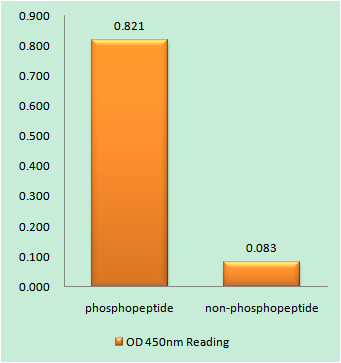NMDAζ1 (phospho Ser890) Polyclonal Antibody
- Catalog No.:YP1135
- Applications:IHC;IF;ELISA
- Reactivity:Human;Mouse;Rat
- Target:
- NMDAR1
- Fields:
- >>Ras signaling pathway;>>Rap1 signaling pathway;>>Calcium signaling pathway;>>cAMP signaling pathway;>>Neuroactive ligand-receptor interaction;>>Circadian entrainment;>>Long-term potentiation;>>Glutamatergic synapse;>>Alzheimer disease;>>Amyotrophic lateral sclerosis;>>Huntington disease;>>Spinocerebellar ataxia;>>Prion disease;>>Pathways of neurodegeneration - multiple diseases;>>Cocaine addiction;>>Amphetamine addiction;>>Nicotine addiction;>>Alcoholism
- Gene Name:
- GRIN1
- Protein Name:
- Glutamate [NMDA] receptor subunit zeta-1
- Human Gene Id:
- 2902
- Human Swiss Prot No:
- Q05586
- Mouse Gene Id:
- 14810
- Mouse Swiss Prot No:
- P35438
- Rat Gene Id:
- 24408
- Rat Swiss Prot No:
- P35439
- Immunogen:
- The antiserum was produced against synthesized peptide derived from human NMDAR1 around the phosphorylation site of Ser890. AA range:856-905
- Specificity:
- Phospho-NMDAζ1 (S890) Polyclonal Antibody detects endogenous levels of NMDAζ1 protein only when phosphorylated at S890.
- Formulation:
- Liquid in PBS containing 50% glycerol, 0.5% BSA and 0.02% sodium azide.
- Source:
- Polyclonal, Rabbit,IgG
- Dilution:
- IHC 1:100 - 1:300. IF 1:200 - 1:1000. ELISA: 1:40000. Not yet tested in other applications.
- Purification:
- The antibody was affinity-purified from rabbit antiserum by affinity-chromatography using epitope-specific immunogen.
- Concentration:
- 1 mg/ml
- Storage Stability:
- -15°C to -25°C/1 year(Do not lower than -25°C)
- Other Name:
- GRIN1;NMDAR1;Glutamate [NMDA] receptor subunit zeta-1;N-methyl-D-aspartate receptor subunit NR1;NMD-R1
- Molecular Weight(Da):
- 105kD
- Background:
- The protein encoded by this gene is a critical subunit of N-methyl-D-aspartate receptors, members of the glutamate receptor channel superfamily which are heteromeric protein complexes with multiple subunits arranged to form a ligand-gated ion channel. These subunits play a key role in the plasticity of synapses, which is believed to underlie memory and learning. Cell-specific factors are thought to control expression of different isoforms, possibly contributing to the functional diversity of the subunits. Alternatively spliced transcript variants have been described. [provided by RefSeq, Jul 2008],
- Function:
- function:NMDA receptor subtype of glutamate-gated ion channels with high calcium permeability and voltage-dependent sensitivity to magnesium. Mediated by glycine. This protein plays a key role in synaptic plasticity, synaptogenesis, excitotoxicity, memory acquisition and learning. It mediates neuronal functions in glutamate neurotransmission. Is involved in the cell surface targeting of NMDA receptors.,online information:NMDA receptor entry,PTM:NMDA is probably regulated by C-terminal phosphorylation of an isoform of NR1 by PKC. Dephosphorylated on Ser-897 probably by protein phosphatase 2A (PPP2CB). Its phosphorylated state is influenced by the formation of the NMDAR-PPP2CB complex and the NMDAR channel activity.,similarity:Belongs to the glutamate-gated ion channel (TC 1.A.10) family.,subcellular location:Enriched in post-synaptic plasma membrane and post-synaptic densities.,subunit:Fo
- Subcellular Location:
- Cell membrane ; Multi-pass membrane protein . Cell junction, synapse, postsynaptic cell membrane . Cell junction, synapse, postsynaptic density . Enriched in postsynaptic plasma membrane and postsynaptic densities. .
- Expression:
- Brain,Cerebellum,Hippocampus,
- June 19-2018
- WESTERN IMMUNOBLOTTING PROTOCOL
- June 19-2018
- IMMUNOHISTOCHEMISTRY-PARAFFIN PROTOCOL
- June 19-2018
- IMMUNOFLUORESCENCE PROTOCOL
- September 08-2020
- FLOW-CYTOMEYRT-PROTOCOL
- May 20-2022
- Cell-Based ELISA│解您多样本WB检测之困扰
- July 13-2018
- CELL-BASED-ELISA-PROTOCOL-FOR-ACETYL-PROTEIN
- July 13-2018
- CELL-BASED-ELISA-PROTOCOL-FOR-PHOSPHO-PROTEIN
- July 13-2018
- Antibody-FAQs
- Products Images

- Enzyme-Linked Immunosorbent Assay (Phospho-ELISA) for Immunogen Phosphopeptide (Phospho-left) and Non-Phosphopeptide (Phospho-right), using NMDAR1 (Phospho-Ser890) Antibody

- Immunofluorescence analysis of A549 cells, using NMDAR1 (Phospho-Ser890) Antibody. The picture on the right is blocked with the phospho peptide.

- Immunohistochemistry analysis of paraffin-embedded human brain, using NMDAR1 (Phospho-Ser890) Antibody. The picture on the right is blocked with the phospho peptide.



